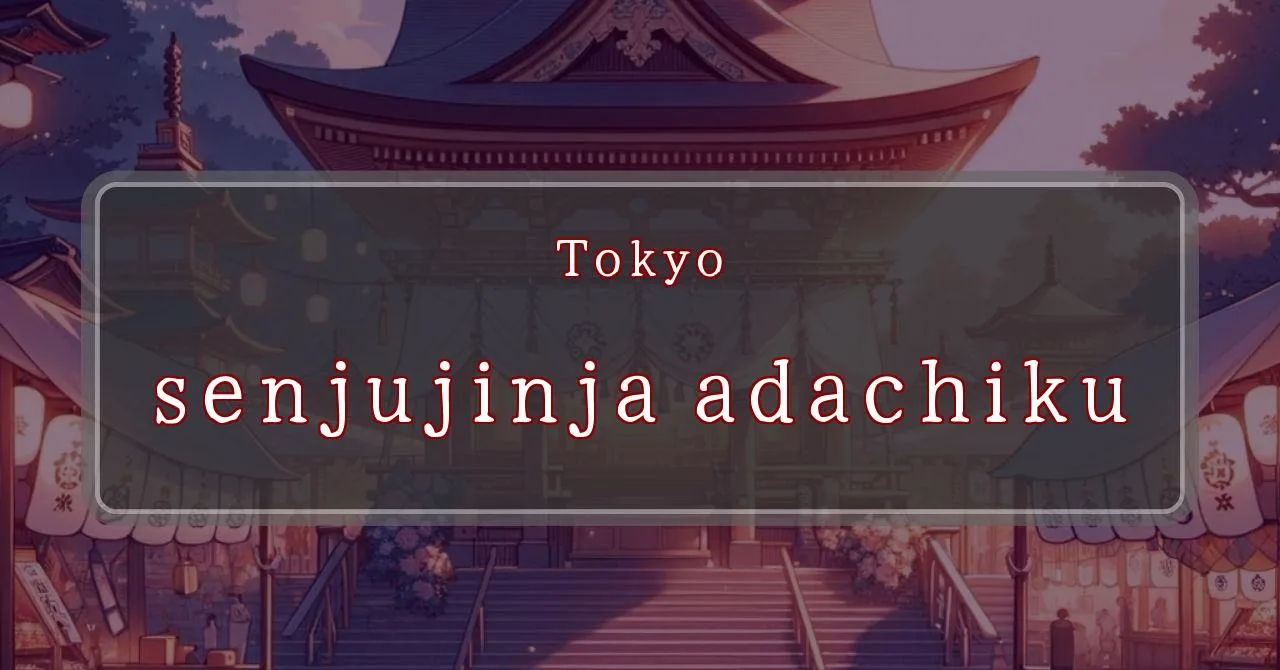Enchanting melodies and vibrant colors at Senju Shrine
Basic Information
Senju Shrine is a historical shrine located in Adachi Ward, Tokyo, Japan. It is dedicated to the deities Ukanomitama-no-Mikoto, the god of food and agriculture, and Susanoo-no-Mikoto, the god of storms and the sea.
- Address: 24-1 Senju Miyamotcho, Adachi-ku, Tokyo 120-0043
- Phone Number: 03-3881-1768
- Access: 15-minute walk from Kita-Senju Station on the JR Joban Line, Tokyo Metro Hibiya Line, Chiyoda Line, and Tobu Skytree Line, or a 7-minute walk from Senju-Ohashi Station on the Keisei Line.
- Festival Days: Second Saturday and Sunday of September
Main Events and Attractions of the Festival
The Senju Shrine Festival is a vibrant and colorful event that attracts many visitors each year. The festival features a variety of events and attractions, including:
Mikoshi Procession
One of the main highlights of the festival is the mikoshi procession. On the second Saturday of September, ten mikoshi (portable shrines) from local shrines are paraded through the streets of Adachi Ward. The mikoshi are carried by teams of people and accompanied by music and dancing. The procession is a lively and energetic event that draws large crowds of spectators.
Yatai (Food Stalls)
During the festival, the streets around Senju Shrine are lined with yatai (food stalls) selling a variety of delicious Japanese food and snacks. Visitors can enjoy everything from traditional festival favorites like takoyaki (octopus balls) and yakisoba (fried noodles) to more unique offerings like grilled eel and sashimi. The yatai are a great place to sample some of the best food that Adachi Ward has to offer.
Shinto Rituals
In addition to the mikoshi procession and the yatai, the Senju Shrine Festival also features a number of Shinto rituals. These rituals are performed by the shrine’s priests and are a chance for visitors to learn more about Japanese culture and religion. Some of the rituals that are performed during the festival include kagura (sacred music and dance), omikuji (fortune-telling), and ema (votive plaques).
Entertainment
The Senju Shrine Festival also features a variety of entertainment, including live music, dancing, and traditional Japanese games. There is something for everyone to enjoy at the festival, making it a great place to spend a day with family and friends.
Blessings and Deities
Senju Shrine is dedicated to two deities: Ukanomitama-no-Mikoto, the god of food and agriculture, and Susanoo-no-Mikoto, the god of storms and the sea. Ukanomitama-no-Mikoto is said to bring abundant harvests and prosperity, while Susanoo-no-Mikoto is revered for his role in slaying the eight-headed serpent Yamata no Orochi and saving the maiden Kushinada-hime. Visitors to the shrine pray for good fortune in their agricultural endeavors, as well as for protection from natural disasters and other misfortunes.
Origin and History
The origins of Senju Shrine are unclear, but it is believed to have been founded in the 9th century. The shrine was originally dedicated to Inari, the god of rice and agriculture. In the 13th century, the shrine was merged with the nearby Hikawa Shrine, which was dedicated to Susanoo-no-Mikoto. The combined shrine was renamed Senju Shrine in the 16th century.
Tips and Notes for Visitors
When visiting Senju Shrine, there are a few things to keep in mind:
- The shrine is open daily from 8:00 AM to 5:00 PM.
- Admission to the shrine is free.
- There is a small parking lot available for visitors.
- The shrine is a popular destination for weddings and other ceremonies, so it is best to avoid visiting during these times if you are looking for a quiet and peaceful experience.
- Photography is permitted within the shrine grounds, but please be respectful of other visitors and avoid taking pictures of people without their permission.
Parking Information
There is a small parking lot available for visitors to Senju Shrine. The parking lot is located on the east side of the shrine, just off of Senju Miyamotcho Street. There is a fee to park in the lot, but the exact amount is not specified.
Popular Stalls and Food Carts in Recent Years
| Type of Stall | Description |
|---|---|
| Takoyaki | A staple at Japanese festivals. Characterized by a crispy outside and a creamy inside. |
| Jaga Butter | A simple yet popular snack of hot potatoes lavishly topped with melted butter. |
| Baby Castella | Small castella cakes, sweet and fluffy treats enjoyed by children and adults alike. |
| Grilled Ayu with Salt | Fresh ayu fish grilled whole with salt, a savory taste of Japanese summer. |
| Shaapin | A unique gourmet item influenced by foreign cuisine, with a chewy skin wrapping the filling. |
| Okonomiyaki | A Japanese grilled dish where you often choose your own ingredients for a personalized flavor. |
| Cotton Candy | A fluffy, sweet snack that’s extremely popular with children. |
| Chocolate Banana | A banana coated in chocolate, a fun and visually appealing dessert. |
| Kushiyaki | Various types of ingredients skewered and grilled, an easy-to-enjoy snack. |
| Yakisoba | Fried noodles mixed with a special sauce, a fast food favorite in Japan. |



